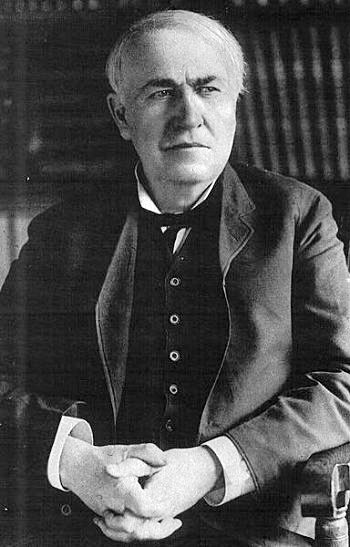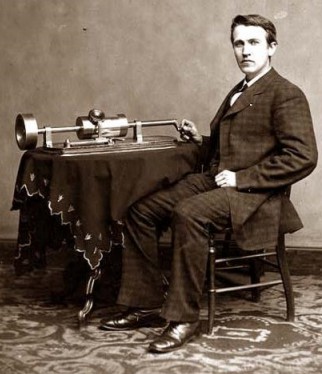No Edison
Antique phonographs from various manufacturers
Thomas Edison

Where would we be today without the genius of Thomas Edison? To say that he invented the modern world would not be overstating his achievements. profoundly affected the technology of modern societyHis inventions have profoundly affected the technology of today's world. He invented the electric lightbulb, recorded sound, a major invention in moving pictures, and efficient ways to generate and distribute electricity. His company was the first to light streets with electric lights. While today automobile companies try to make an electric car, Edison had already built one in 1914.
Thomas Alva Edison was born on February 11, 1847 in Milan, Ohio; the seventh of seven children. When Edison was seven his family moved to Port Huron, Michigan. where he lived until he was sixteen. Edison had very little formal education. As a child, attending school only for a few months. His teachers considered him disruptive as he continually asked questions. He was taught reading, writing, and arithmetic by his mother, and taught himself much by reading on his own. This belief in self-reliance and self-improvement remained a trait throughout his life.
At twelve he took a job selling newspapers and sweets on the local railroad that ran from Port Huron to Detroit. Not being allowed to experiment with chemicals at home, he set up a lab in an empty freight car. Edison also began printing a weekly newspaper, which he called the Grand Trunk Herald, that he sold to passengers.
While Edison was working the railroad, Edison saved the life of a station official's child, who had fallen onto the tracks of an oncoming train. For his bravery, the boy's father taught Edison how to use the telegraph. By the time he was sixteen, he was proficient enough to work as a telegrapher full time.
From 1862 to 1868, Edison worked as a roving telegrapher in the Midwest, the South, Canada, and New England. During this time, he began developing a telegraphic repeating instrument that made it possible to transmit messages automatically. By 1869, Edison's inventions, including the duplex telegraph and message printer, were progressing so well, he left telegraphy and began a career of full-time inventing and entrepreneurship.
The Invention of the Phonograph
In 1877, Edison
received money from his invention of thecarbon-button transmitter (that
is still used today in telephone speakers and microphones). He had just build a new laboratory and machine shop
in Menlo Park, New Jersey.
Edison, in late 1877 was trying to create a machine that would transcribe telegraphic messages by making indentations on paper tape. These tapes could later be sent over the telegraph repeatedly.
This development led Edison to speculate that a telephone message could also be recorded in a similar fashion. He experimented with a diaphragm which had an embossing point and was held against rapidly-moving paraffin paper. Edison - who was already loosing his hearing - felt that the stylus was vibrating in a unique way and deduced that if one could capture the sound vibrations, one could also possibly play them back!
Edison made a sketch of a machine that he thought could accomplish this task, and gave this sketch of the machine to his mechanic, John Kreusi, to build. Within 2 days the machine was ready. Edison immediately tested the machine by speaking the nursery rhyme into the mouthpiece, "Mary had a little lamb." To his amazement, the machine played his words back to him.

This development led Edison to speculate that a telephone message could also be recorded in a similar fashion. He experimented with a diaphragm which had an embossing point and was held against rapidly-moving paraffin paper. Edison - who was already loosing his hearing - felt that the stylus was vibrating in a unique way and deduced that if one could capture the sound vibrations, one could also possibly play them back!
Edison made a sketch of a machine that he thought could accomplish this task, and gave this sketch of the machine to his mechanic, John Kreusi, to build. Within 2 days the machine was ready. Edison immediately tested the machine by speaking the nursery rhyme into the mouthpiece, "Mary had a little lamb." To his amazement, the machine played his words back to him.

If we did all the things we are capable of, we would literally astound ourselves.
Thomas A. Edison